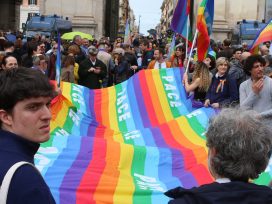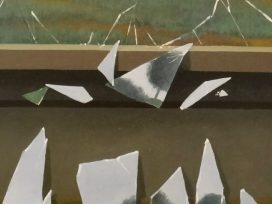The radical rightwing party Svoboda rose to prominence in Ukraine’s 2012 parliamentary elections as an alternative to the political establishment, writes Anton Shekhovtsov, expert on Ukrainian rightwing groups. But its role in Euromaidan may well amount to Svoboda’s swan song.
The relatively strong performance of the radical rightwing political party Svoboda in the 2012 parliamentary elections surprised many political scientists, even those whose research is focused on contemporary Ukrainian politics. Indeed, the 10.44 per cent of the popular vote that Svoboda obtained was the best result for a Ukrainian far-right party since the demise of the Soviet Union in 1991. Moreover, even if individual far-right politicians managed to become members of the Ukrainian parliament before 2012, their numbers were never sufficient to form a far-right parliamentary group. Svoboda became the first such party to achieve this.
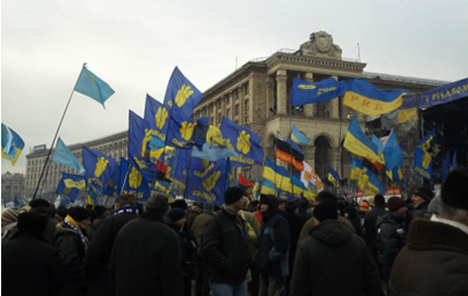
Svoboda’s flags seemed over-represented at Euromaidan but the popularity of the party was doubtful. Photo: Anton Shekhovtsov.
Svoboda was founded in 1991 in Lviv as the Social-National Party of Ukraine (SNPU), under the leadership of Yaroslav Andrushkiv. The SNPU was officially registered as a political party in 1995 and, thereafter, took part in several parliamentary elections to no avail. The SNPU’s only relevant political success was the election of one of its leaders, Oleh Tyahnybok, to the Ukranian parliament or “Verkhovna Rada” (literally, “supreme council”) in 1998 and 2002, representing single-member districts in the Lviv oblast. However, it was Viktor Yushchenko’s rightwing electoral bloc “Our Ukraine” (Nasha Ukrayina) and not the SNPU that nominated Tyahnybok in 2002, a sign that the organizational decline of the SNPU had started to set in. Tyahnybok made an attempt to revive the party: following the SNPU congress in 2004, it changed its name to “Svoboda” (Vseukrayinske obyednannia “Svoboda”, or, All-Ukrainian Union “Svoboda”1 in full), replaced Andrushkiv with Tyahnybok as the head of the party and made several other changes intended to “reinvigorate” the organization and make it more respectable in the eyes of voters. Despite these changes, Svoboda’s results in the 2006 and early 2007 parliamentary elections, 0.36 per cent and 0.76 per cent respectively, provided no evidence of growing popularity.2
Svoboda’s success in the 2012 parliamentary elections
Its success in the 2012 parliamentary elections followed strong performances in the regional elections in 2009 and 2010. However, this, together with the obvious ethno-nationalist nature of Svoboda’s ideology, could hardly be interpreted as an indication of the growth of xenophobia or racism in Ukrainian society. It was a complex combination of several factors that led to the outcome of elections in 2012.
First of all, Svoboda was considered one of the very few Ukrainian parties able to lay claim to an ideology of any kind whatsoever. The problematic nature of this ideology, namely its radical rightwing orientation, was of little significance to many Svoboda voters. In a climate dominated by what was perceived as the widespread cynicism of all established political parties and where spin-doctoring had long been a substitute for real political ideas, Svoboda had a clear advantage: it stuck to its guiding principles established in the mid-1990s and its leaders rarely deviated from the party line.
Second, Svoboda was seen as a new and radical political force, a real alternative to the existing opposition to the Party of Regions and president Viktor Yanukovych, which consisted at the time of Fatherland (Bat’kivshchyna), formally led by Oleksandr Turchynov and Arseniy Yatsenyuk in lieu of the then imprisoned Yulia Tymoshenko, and Our Ukraine, headed by Viktor Yushchenko. There was a certain sense of weariness among voters: politicians from Fatherland and Our Ukraine had already been in power, and their performance was interpreted as disappointing. The same demand for new politics was one of the determinants of the electoral success of Vitali Klitschko’s UDAR (Ukrainian Democratic Alliance for Reform), which had not previously been represented in the Verkhovna Rada and obtained 13.96 per cent of the vote in 2012.
Third, Svoboda significantly benefitted from the decline of the mainstream nationalist party Our Ukraine and the increasingly unpopular Yushchenko. The downfall of Yushchenko and his party had created a vacant rightwing niche in the Ukrainian political spectrum that Svoboda managed to fill. Moreover, Svoboda did not have to contest this niche with any other nationalist parties, which had either discredited themselves or declined as organizations.
Fourth, since 2010, Svoboda had enjoyed increased visibility in the media. Its representatives often appeared in popular TV shows hosted by TV networks directly or indirectly controlled by Yanukovych and the government headed by Mykola Azarov. It seems viable to suggest that Yanukovych wanted to promote Svoboda in order to damage the mainstream opposition. Indeed, as the results of the early regional elections in Ternopil showed, Svoboda’s advance took place at the expense of electoral support for mainstream opposition parties. The authorities wanted to take advantage of this and presumably instructed the management of certain TV networks (first and foremost, Inter and Pershy Natsional’ny) to invite Svoboda’s representatives to TV shows on a regular basis.3
Fifth, Svoboda’s cooperation with mainstream political parties within the framework of the Committee against Dictatorship, which was created in response to the political persecution of Tymoshenko, and other structures opposing Yanukovych contributed to its political and social legitimacy and, thus, to its acceptance by the public. Moreover, in the run-up to the elections, Svoboda declared that it would work together with Fatherland and UDAR in parliament. Hence, the voters who opposed the Party of Regions and the Communist Party of Ukraine could choose between the moderates (Fatherland, UDAR) and radicals (Svoboda), without any fear of splitting the vote for the opposition.
Sixth, Svoboda conducted a dynamic electoral campaign that followed a wave of active protests between 2010 and 2012. Importantly, the focus of the party’s street politics was not so much on its stronghold in western Ukraine as on central Ukraine, while the number of protests in eastern and southern Ukraine, where Ukrainian ethnic nationalism had been widely denounced, gradually increased. In 2011, a third of Svoboda’s protests took place in the “alien” eastern regions, while, in 2012, 14 per cent of the protests were held in no less “alien” southern Ukraine.4
Finally, Svoboda benefitted from the policies of Yanukovych and the Party of Regions, which were seen as unpatriotic and anti-Ukrainian. Most prominently, the so-called Kharkiv Accords that extended the Russian lease on naval facilities in the Crimea to 2042 (previous to which, the lease was due to expire in 2017) had enraged nationally conscious voters and radicalized their vote, as had the adoption of a controversial law granting official status to the Russian language in regions where it is predominantly spoken.5
The last point reveals the dual nature of Svoboda’s ideology, which comprises on the one hand the rightwing radicalism that defines the party and, on the other, a manifest ethos of a national liberation struggle against an external threat (Russia) and “internal colonization”.6
According to Cas Mudde, radical rightwing populism is “a combination of three core ideological features: nativism, authoritarianism and populism”.7 Nativism, in Mudde’s terms, can be understood as “an ideology, which holds that states should be inhabited exclusively by members of the native group (‘the nation’) and that non-native elements (persons and ideas) are fundamentally threatening to the homogenous nation-state”.8 Svoboda’s ideology displays all three features, but its nativism overlaps with the quest for national liberation. In this sense, Svoboda can be – to a certain degree – compared to the far-right Vlaams Belang (Flemish Interest) in Belgium. This party’s ideology also has a dual character: it includes the three radical rightwing features, but its nativism overlaps with a separatist vision for Flanders.
As Andreas Umland put it, “over the last twenty years, leading Russian politicians and intellectuals have repeatedly let it be understood, explicitly or implicitly, that they do not consider the existing state border [of Ukraine] permanent”. This constitutes, in Umland’s terms, “a real external danger to Ukraine”, and, for many Ukrainians voters, Svoboda’s strong discursive focus on this threat has eclipsed its rightwing radicalism.9
Svoboda’s European links: From rightwing radicals to neo-Nazis
Svoboda’s national liberationist ethos, however, was always a product for domestic consumption, and there is no evidence that Svoboda has ever cooperated with any non-Ukrainian anti-imperialist movement or party. At the same time, Svoboda has always strived to cooperate with European radical rightwing parties and used its European connections for public relations, image and propaganda purposes.
In 2000, SNPU leaders established contact with Euronat, an association of European far-right parties, the declared mission of which was “to associate all national and patriotic political parties and movements in Europe”.10 The same year, Jean-Marie Le Pen, then the leader of the French Front national, took part in the party congress of Svoboda.11
Despite the fact that Euronat was a short-lived association, Svoboda maintained contacts with Front national. It was Front national’s image-makers who offered advice on how to turn the SNPU into a more respectable party. SNPU leaders “rebranded” their party accordingly in 2004.
The contacts between Svoboda and its EU counterparts intensified after Svoboda’s landslide victory in an early election in the Ternopil oblast in 2009, when it obtained 34.69 per cent of the vote. Its nearest competitor, the United Centre, gained only 14.20 per cent.12 After the election, Tyahnybok went to Strasbourg, where Le Pen and Bruno Gollnisch, then Front national general delegate, congratulated him on Svoboda’s victory. In Strasbourg, Tyahnybok also met with MEPs from the European radical rightwing parties such as the Freiheitliche Partei Österreichs (FPÖ, or, “Freedom Party of Austria”), Ataka, (“Attack”, Bulgaria), Vlaams Belang (“Flemish Interest”, Belgium), Forza Nuova (“New Force”, Italy) and Fiamma Tricolore (“Tricolour Flame”, Italy).13
In the second half of 2009, Tyahnybok went to Nanterre, where he and Le Pen signed a memorandum of cooperation between Svoboda and the Front national aimed at “the preservation of national identity and culture [of Ukraine and France], the prevention of the influx of immigrants and the preservation of national Christian values of European nations”.14
At the end of 2009, Tyahnybok went to Rome to take part in the party congress of Tricolour Flame. A few months before Tyahnybok’s visit to Rome, Fiamma Tricolore, along with Front national, Jobbik (Hungary), Nationaldemokraterna (or National Democrats, Sweden) and the Belgian Front national, founded the Alliance of European National Movements (AENM), yet another association of the EU-based far-right parties. Representatives of the AENM visited Fiamma Tricolore’s party congress too, and Tyahnybok’s talks with them resulted in their decision to grant Svoboda an observer status in the AENM in 2010.15
January 2010 was a busy month for Svoboda’s international relations. The French Front national’s Thibaut de La Tocnaye visited Kyiv and took part in a joint conference with Svoboda’s leadership, and a few days later Tyahnybok went to Strasbourg to take part in the AENM’s first press conference. By that time, the AENM had expanded to eight parties and included, in addition to the five founding members, the British National Party (BNP), Spain’s Movimiento Social Republicano (Republican Social Movement) and Portugal’s Partido Nacional Renovador (National Renovator Party).
The joint declaration of the AENM called for the “creation of a Europe of free, independent and equal nations in the framework of a confederation of sovereign nation-states, refraining from taking decisions on matters properly taken by states themselves”.16 Later in 2010, Svoboda’s representative went to Graz, Austria, to meet Armin Sippel of the FPÖ and Gerald Grosz of the Bündnis Zukunft Österreich (BZÖ, or, “Alliance for the Future of Austria”).17 Since then, Svoboda’s relations with the European far Right were relatively stable up until the beginning of 2013.
In January 2013, however, Mateusz Piskorski, a former member of the Polish national-populist Samoobrona (Self-Defence) told one Ukrainian media outlet that Svoboda had been excluded from the AENM, because Svoboda appeared to display “some kind of a pathology of a Hitlerite type” and this party had “no friends in Europe, with the exception of perhaps German neo-fascists”.18 Piskorski’s description of Tyahnybok’s party was obviously an exaggeration, as not only did Svoboda cooperate with several European radical rightwing parties (and, as noted above, it cooperated with the Front national even during the SNPU days), but also could not be considered a neo-Nazi party.
Svoboda promptly denied Piskorski’s allegations, making reference to Front national general delegate Bruno Gollnisch, who had allegedly confirmed Svoboda’s continuing participation in the AENM.19
But the reference to Gollnisch was questionable, because Svoboda did not take part in some important meetings of the AENM in 2012,20
while Gollnisch himself never commented publicly either on Piskorski’s or Svoboda’s statements.
In March 2013, the AENM’s treasurer and Jobbik MEP Béla Kovács drew a line under the confusion concerning Svoboda’s relations with the Alliance. Kovács wrote an official letter to Tyahnybok, in which he expressed in the strongest terms his indignation over the fact that Svoboda’s members had allegedly organized rallies against ethnic Hungarians in Ukrainian Carpathian Ruthenia, part of which once belonged to Hungary.21 Kovács ended his letter by informing Tyahnybok that Svoboda’s observer status in the AENM had been terminated and they had no intention to cooperate with Svoboda in any way whatsoever.
After Svoboda had been deprived of observer status in the AENM, Tyahnybok’s party started looking for new connections in the EU. A few days after Kovács’s letter, Taras Osaulenko, head of Svoboda’s international relations, took part in the Vision Europa conference organized by Svenskarnas parti (Party of the Swedes) in Stockholm. Svenskarnas parti is usually described as a fascist/neo-Nazi organization;22 it was established in 2008 by members of the now dissolved Nationalsocialistisk front (National Socialist Front) and is led by Stefan Jacobsson. The main speaker at the conference appeared to be Udo Pastörs, deputy leader of the most significant neo-Nazi party to emerge since 1945, the Nationaldemokratische Partei Deutschlands (NPD, or, National Democratic Party of Germany).
Another speaker at the conference was Roberto Fiore, leader of the Italian fascist Forza Nuova (“New Force”). European guests present included: Jonathan Le Clercq of the French Terre et Peuple (Land and People) association; Daniel Carlsen, leader of Danskernes Parti (Party of the Danes); and Gonzalo Martín Garcia, head of international relations of the Spanish Democracia Nacional (“National Democracy”).
The links between Svoboda and Fiore were further consolidated in May and June 2013. On 23 and 24 May, Osaulenko and Svoboda MP Andriy Illenko visited Rome at Fiore’s invitation, to discuss collaboration between the two parties with Forza Nuova’s leadership. Svoboda’s representatives also visited Forza Nuova’s youth camp and Illenko gave a talk about his party’s history and ideology, as well as sharing his thoughts on how the two parties could join forces in their “fight against the liberal forces of multiculturalism and the destruction of the national traditions of European civilization”.23
On 19 and 21 June, representatives of Forza Nuova, including its leader Roberto Fiore, visited Ukraine. The Italian and Ukrainian ultranationalists discussed the creation of a new group of European nationalist movements in order to “develop a new dynamic and strategic co-operation aimed at creating a new European political class”.24
Supposedly, the new group was to incorporate the organizations that had taken part in the Vision Europa conference in Stockholm.
In the interim, on 29 May 2013, another Svoboda MP, Mykhaylo Holovko, visited the Landtag of Saxony to speak to the NPD. Holovko conveyed greetings from Tyahnybok and Serhiy Nadal, Svoboda’s mayor of the Ukrainian city of Ternopil. Svoboda and the NPD agreed to strengthen bilateral relations between the parties and parliamentary groups.
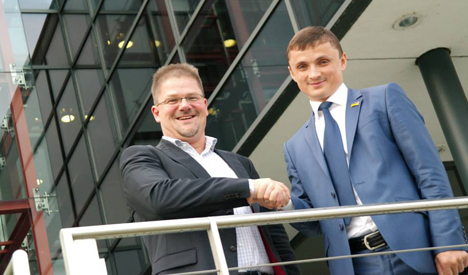
Holger Apfel, leader of the NPD (2011-2013), and Mykhaylo Holovko. Source:NPD-Fraktion im Sächsischen Landtag
It remains to be seen whether Svoboda’s visits to its EU-based counterparts contribute to the creation of a new pan-European ultranationalist movement. None of the parties represented at the Vision Europa conference is a member of the AENM, while Fiore’s Forza Nuova is unlikely to cooperate with the AENM member from Fiamma Tricolore, from which it split in 1997. Fiore’s previous “ecumenical” fascist project, the European National Front, which united representatives from Forza Nuova, the NPD, the Romanian Noua Dreapta (New Right), the Greek Golden Dawn and the Spanish Falange, has failed. Therefore, it seems plausible to suggest that Svoboda’s European counterparts outside the AENM need a new umbrella organization.
Svoboda and Euromaidan
Svoboda’s active participation in the pro-European, pro-democratic protests that unfolded in late November 2013 as a response to Yanukovych’s u-turn on the signing of the Association Agreement with the EU, may seem like a double paradox.25 First of all, Svoboda’s former and present counterparts in the EU – be they associated with the AENM or with the embryonic extreme right association around Roberto Fiore – have always opposed the EU and its liberal democratic values of freedom and equality. Second, Svoboda itself criticized the EU and rejected Ukraine’s European integration. As Svoboda MP Andriy Illenko argued in 2010, Ukraine’s rapprochement with the EU implied “acceptance of a cosmopolitan ideology, dissolution of the modern liberal empire, and submission to the […] gradual loss of national identity”.26
Why, then, has Svoboda supported the pro-democratic and pro-European protests collectively known as Euromaidan? What has compelled Svoboda’s leadership to support those Ukrainians who aspire to “dissolve” Ukraine in “the ocean of transnational capital and migration flows”?27
The following three explanations seem the most worthy of consideration: (1) Svoboda views Ukraine’s European integration as a definitive turn away from all Russia-led Eurasian integration projects, (2) the party has recognized the pro-European attitudes of its voters, and (3) Svoboda views Euromaidan, which quickly evolved into a revolution,28 as a platform for self-promotion and propaganda. Let us consider these explanations in more detail.
The prospect of signing of the Association Agreement between Ukraine and the EU was widely seen, not only by Svoboda’s leadership, as an almost irrevocable withdrawal from the Russian sphere of influence as represented by the Customs Union of Belarus, Kazakhstan and Russia, as well as the Eurasian Union planned to be launched in 2015. From the very beginning, Ukraine’s choice between the EU and Customs Union was presented as a “zero-sum game”. In February 2013, European Commission president Jose Manuel Barroso said that “one country [could not] at the same time be a member of a customs union and be in a free trade area with the European Union”.29 In October that year, the Austrian ambassador to Ukraine Wolf Dietrich Heim also said that Ukraine could not “work simultaneously in two areas: as part of the agreement on the creation of a free trade area and as part of the Customs Union”.30 The same argument was acknowledged by Russian president Vladimir Putin.31
As the perceived Russian threat to Ukraine had always been the most powerful mobilizing element in Svoboda’s ideology, the party had no other choice than actively to support the signing of the Association Agreement with the EU. Thus, as the “zero-sum game” unfolded, the “modern liberal empire” was seen as a lesser evil than the Customs Union, “a soap bubble for the revival of the Russian Empire in the new old Soviet Union”.32
It is, therefore, hardly surprising that Svoboda enjoyed the support of the most pro-European electorate among any Ukrainian party elected into the Verkhovna Rada in 2012. According to the opinion poll conducted by the Ilko Kucheriv Democratic Initiatives Foundation,33 71.4 per cent of Svoboda’s voters were in favour of Ukraine’s integration with Europe. At the same time, the numbers for the electorates of UDAR and Fatherland were 69.5 per cent and 63.8 per cent correspondingly. When asked whether they considered themselves Europeans, 51.2 per cent of Svoboda’s voters gave a positive reply; the numbers for the electorates of UDAR and the Fatherland are 44.5 per cent and 40.6 per cent.
Moreover, when asked to choose three out of eight options in a reply to the question “What is needed for you to feel a European”, 46.2 per cent of Svoboda’s voters chose “To respect democratic values and human rights”, while 31.7 per cent chose “To have fair democratic elections”. The numbers for the electorates of the Fatherland and UDAR were 39.5 per cent and 38.4 per cent for the former option, and 21.9 per cent and 19.2 per cent for the latter. It may seem surprising or even confusing that supporters of the far-right party at the 2012 parliamentary elections turned out be more pro-European and pro-democratic than voters for the two democratic parties. However, this problem appears confusing only at first sight: for many Ukrainian voters, the rejection of Russia-led integration projects was underpinned by the rejection of authoritarianism and the collapse of the rule of law usually associated with the contemporary Kremlin’s policies. Thus, Svoboda’s radically negative attitudes towards Putin’s Russia were re-interpreted by many Ukrainian pro-democratic voters as radical opposition to authoritarianism and backwardness. Svoboda’s leadership could not ignore the distinctly pro-EU stances of the majority of its voters, and abandoned the anti-EU rhetoric that might have alienated most of its electorate.
To Svoboda, the Euromaidan protests seemed to be a good opportunity to reclaim the popular support that they had lost within a year of the party’s electoral success in 2012. Svoboda obtained 10.44 per cent of the vote in October 2012, but in November 2013 only 5.1 per cent of the voters would have cast a ballot for this party.34
Even more dramatically, Tyahnybok’s presidential rating fell from 10.4 per cent in March35 to 5.8 per cent in May36 and to 3.6 per cent in November 2013.37
At first, Svoboda resolutely plunged into the revolution. The courage and valour that their members (but not only they) showed during the defence of Independence Square – the heart of the revolution – against the Berkut riot police on 9 December 2013 contributed to the morale of the protesters. However, Svoboda’s fighting units were reluctant to take part in the most significant clashes with the police forces between 19 and 22 January and 18 and 19 February 2014, although individual members of the party did participate here too.
For the most part, Svoboda made a negative impact on the revolution. The party, and especially its paramilitary wing called C14 under the leadership of the notorious neo-Nazi Yevhen Karas, became involved in a number of divisive activities. Displaying racist banners in the occupied Kyiv City State Administration, attacking journalists, volunteer medical workers and other Euromaidan activists, demolishing the Lenin monument, staging a torch-lit march commemorating controversial Ukrainian ultranationalist Stepan Bandera – all these activities damaged the unity, as well as the image, of Euromaidan.38 Furthermore, according to documents revealed by Hennadiy Moskal, the Fatherland MP and former deputy chairman of the Security Service of Ukraine (SBU), the security services actively recruited agents and informants among many parties and movements, and from Svoboda in particular.39 Out of 19 agents and informants presumably recruited by the SBU, nine were members of Svoboda.
Moreover, the Euromaidan protests presented Svoboda with an unexpected problem: from the very beginning, the protests were a grassroots initiative. The majority of the protesters were very suspicious of the involvement of the three major opposition parties (Fatherland, UDAR and Svoboda) in Euromaidan. Little more than five per cent of participants in Euromaidan in Kyiv were mobilized by the calls of the opposition leaders in December 2013; and by January 2014, the figure had decreased to less than two per cent. Furthermore, only 3.9 per cent of the Kyiv protesters in December 2013 and 7.7 per cent in January 2014 were members of any political party.40 The protesters’ concerns that the leaders of the opposition parties might betray the protests and simply use Euromaidan to secure their own bargaining power applied to all opposition parties, but Svoboda was particularly affected. Even in Lviv, Svoboda’s long-time bulwark, the MP Yuriy Mykhal’chyshyn was booed by the students who organized a local Euromaidan rally at the end of November 2013.41
Tyahnybok’s party, which coordinated most of its activities with the other two opposition parties represented in the parliament, yet at the same time clashed with various elements of the civic movement, was increasingly seen as a noisy nuisance, whose radical rhetoric did not match its actions.42 As Ostap Drozdov put it in his article on Svoboda’s “parasitic role” in the revolution, “within just a few weeks, the country has witnessed a real fiasco for the party that blatantly promised to lead the revolution, but, instead, not only became its obstacle, but also its most flawed element”.43
Two months after the start of Euromaidan, less than three per cent of Ukrainians thought that Tyahnybok ought to become a leader of the protests44 – a figure that suggests Svoboda had effectively failed at Euromaidan. Even if it is not a complete fiasco, Svoboda seems to have failed to make amends as regards its dwindling popular support: at the end of January and beginning of February 2014, only 3.8 per cent of voters were prepared to cast their ballot for Tyahnybok at the presidential elections, and 5.6 per cent for Svoboda at the parliamentary elections.45
Svoboda’s political future
Since 2010, the Ukrainian TV networks controlled by Yanukovych’s presidential administration promoted Svoboda in order to damage the democratic opposition to this corrupt authoritarian regime. At the same, Svoboda’s entry into the Verkhovna Rada in 2012 was determined, first and foremost, by its image as the most radical but, at the same time, legitimate opposition party among the political forces opposed to Yanukovych and Azarov’s government. As a parliamentary party, there was a good chance that Svoboda would shift from the far Right to the centre Right and fully secure the niche that had been abandoned by the moderate rightwing Our Ukraine. But Svoboda apparently preferred to keep a foot in both camps. On the one hand, it seemed to conform to the general agenda of the national democratic opposition. On the other, as revealed by Svoboda’s growing relations with Europe’s most extreme rightwing organizations and its admission of the neo-Nazi movement C14, Tyahnybok’s party expressed no desire to leave the far-right end of the political spectrum.
Svoboda’s ambivalent positioning has become destructive for the party, especially during the series of what so far seem to be the most dramatic events in contemporary Ukrainian history – Euromaidan. As a party close to the democratic opposition, it damaged the unity and image of the revolution. As an allegedly radical force, it turned out to be too moderate in the confrontation with Yanukovych’s regime: when non-partisan protesters became radicalized in response to the regime’s brutality and demanded bold and direct action, Svoboda failed to rise to the challenge. Partly because of this, the radical protesters’ sympathies shifted to Pravy Sektor (the Right Sector), a non-party-political coalition of rightwing groups led by Dmytro Yarosh that constituted a part of the generally non-ideological Maidan Self-Defence movement.
While it is perhaps still too early to draw any definite conclusions, the Ukrainian revolution may coincide with Svoboda’s swan song. With the demise of Yanukovych’s regime, Svoboda has lost its most important source of negative voter mobilization. Moreover, although the revolution was painted in ethnic Ukrainian colours, the emergent new nation, having gone – both metaphorically and literally – through fire and water, reveals the traits of an inclusive civic-republican, rather than an exclusivist ethnic, nation. It is hard to imagine significant public acceptance of Svoboda’s exclusivist ethnic rhetoric after the tragic deaths of ethnic Armenian, Belarusian, Russian, Jewish and Georgian protesters, as well as considering the fact that representatives of so many national minorities, including the Crimean Tatars, fought against Yanukovych’s regime.
However, Svoboda’s political future clearly depends on post-revolutionary developments in Ukraine. If Ukraine, with the help of the international community, is unable to stop the Russian invasion, Ukrainian patriotism and national liberation ethos will obviously grow stronger, and Svoboda may use this opportunity to regain its support.
The word "Svoboda" translates as "freedom".
For more on the electoral insignificance of the Ukrainian far Right, see Andreas Umland, Anton Shekhovtsov, "Ultraright party politics in post-Soviet Ukraine and the puzzle of the electoral marginalism of Ukrainian ultranationalists in 1994-2009", Russian Politics and Law 51, no. 5 (2013): 33-58.
On the increased media visibility of Svoboda in the period since 2010 see Anton Shkehovtsov, "Vseukrainskoe ob'yedinenie 'Svoboda': problema legitimnosti bor'by za vlast'", Forum noveyshey vostochnoevropeyskoy istorii i kul'tury 10, no. 1 (2013): 22-63.
Konstantin Fedorenko, "Protestnaya aktivnost' kraynikh pravykh v Ukraine v 2010-2012 gg.: Vseukrainskoe ob'yedinenie 'Svoboda' v sravnitel'noy perspective", Forum noveyshey vostochnoevropeyskoy istorii i kultury 10, no. 1 (2013): 99
See a more detailed analysis of the factors of Svoboda's relative success at the 2012 parliamentary elections in Andreas Umland, "A typical variety of European rightwing radicalism?", Russian Politics and Law 51, no. 5 (2013): 86-95; Viacheslav Likhachev, "Social-nationalists in the Ukrainian parliament: How they got there and what we can expect of them", Russian Politics and Law 51, no. 5 (2013): 75-85; Anton Shekhovtsov, "The All-Ukrainian Union 'Freedom' (Svoboda) at the 2012 parliamentary elections and a longing for a nationalizing state", forthcoming.
On the "internal colonization" of Ukraine see Mykola Ryabchuk, "Ukraina: ne Afryka. Ale scho?", in Zbruc, zbruc.eu/node/10508 (accessed 16 February 2014).
Cas Mudde, Populist Radical Right Parties in Europe, Cambridge University Press, 2007, 22
Ibid.
Umland, "A typical variety of European rightwing radicalism?", 88
Miroslav Mares, "Transnational Networks of Extreme Right Parties in East Central Europe: Stimuli and Limits of Cross-Border Cooperation", Paper prepared for the 20th IPSA World Congress (Section MT03.377) Fukuoka, 9-13 July 2006, ispo.fss.muni.cz/uploads/2download/fukuoka/Mares.pdf (accessed 16 February 2014)
"Istoriya VO 'Svoboda'", Svoboda, www.svoboda.org.ua/pro_partiyu/istoriya/ (accessed 16 February 2014).
See the analysis of Svoboda's victory at the early election in the Ternopil oblast in Anton Shekhovtsov, "From para-militarism to radical rightwing populism: The rise of the Ukrainian far-right party Svoboda", in Ruth Wodak, Brigitte Mral, Majid KhosraviNik (eds), Right Wing Populism in Europe: Politics and Discourse, Bloomsbury Academic, 2013, 256-58.
Vseukrains'ke Ob'ednannya "Svoboda" , April 2009, 2
"Oleh Tyahnybok: 'Zberezhennya natsional'noi identychnosti yevropeys'kykh natsiy -- spil'ne zavdannya yevropeys'kykh pravykh'", Vseukrains'ke Ob'ednannya "Svoboda", January 2010, 5
Since Ukraine is not a member of the EU, Svoboda could not enjoy the full membership in the AENM.
"Alliance of European national movements expands to 9 parties", British National Party, www.bnp.org.uk/news/alliance-european-national-movements-expands-9-parties (accessed 16 February 2014)
"Zustrichi natsionalistiv v avstriys'komu Gratsi", in Vseukrains'ke Ob'ednannya "Svoboda", March 2010, 2
Oksana Shkoda, "'Svoboda' skryvaet svoy proval v Yevrope", 2000, January 2013, 2000.net.ua/2000/derzhava/ekspertiza/87027 (accessed 16 February 2014).
"'Svoboda' bula i zalyshayet'sya uchasnykom Al'yansu yevropeys'kykh natsionalistychnykh rukhiv", Svoboda, 11 January 2013, http://www.svoboda.org.ua/diyalnist/novyny/035488/ (accessed 16 February 2014)
"Bruno Gollnisch re-elected as president of the Alliance of European National Movements", Jobbik, 21 October 2012, www.jobbik.com/bruno_gollnisch_re-elected_president_alliance_european_national_movements (accessed 16 February 2014)
"Kovács Béla nyílt levele az ukrán magyargyulölokhöz", Kuruc.info, 22 March 2013, kuruc.info/r/6/109676/ (accessed 16 February 2014). This information was confirmed to me in an email from Jobbik's Attila Bécsi where he said: "Svoboda is no longer a member of the AENM because of its anti-Hungarian statements".
Bo Nylander, Where Did All the Fascists Go? A Study on the Extreme Right in Lund, Sweden, Lund University, 2010, 11
"Delehatsiya 'Svobody' vidvidala Rym na zaproshennya italiys'koi partii 'Fortsa nova'", Svoboda, 25 April 2013, www.svoboda.org.ua/diyalnist/novyny/038650/ (accessed 16 February 2014).
"Europa delegazione di FN incontra rappresentanti di Svoboda a Kiev", Forza Nuova, www.forzanuova.org/comunicati/europa-delegazione-di-fn-incontra-rappresentanti-di-svoboda-kiev (accessed 16 February 2014).
Svoboda was not the only far right organization that took part in Euromaidan. Other far right organizations' involvement requires a separate discussion and is not analysed here.
Andriy Illenko, "Natsiya chy koloniya?", Svoboda, 24 July 2010, www.svoboda.org.ua/dopysy/dopysy/015905/ (accessed 16 February 2014).
Ibid.
Anton Shekhovtsov, "The Ukrainian revolution is European and national", Eurozine, 13 December 2013, www.eurozine.com/articles/2013-12-13-shekhovtsov-en.html (accessed 16 February 2014).
Barbara Lewis, Adrian Croft, "EU leaders give Kiev until May to prove it wants to look West", Reuters, 25 February 2013, www.reuters.com/article/2013/02/25/us-eu-ukraine-idUSBRE91O0U420130225 (accessed 16 February 2014).
"Association Agreement with EU to develop Ukraine in general -- Austrian ambassador", Ukrinform, 8 October 2013, www.ukrinform.ua/eng/news/association_agreement_with_eu_to_develop_ukraine_in_general___austrian_ambassador_310813 (accessed 16 February 2014).
"Ukraina ne mozhet byt' odnovremenno i v ES, i v Tamozhennom soyuze, podtverdil Putin", ITAR-TASS, 25 October 2013, itar-tass.com/old-ekonomika/711133 (accessed 16 February 2014).
"Oleh Tyahnybok: 'Mytnyy soyuz zamist' 'rayu dlya Ukrainy' poklykanyy vidrodyty rosiys'ku imperiyu v novomu-staromu sovyets'komu soyuzi", Svoboda, 18 December 2012, http://www.svoboda.org.ua/diyalnist/novyny/035026/ (accessed 16 February 2014).
"Stavlennya hromads'kosti do yevropeys'koi intehratsii Ukrainy", Democratic Initiatives Foundation, www.dif.org.ua/ua/polls/2013-year/mlfgblfbllgmkl.htm (accessed 16 February 2014).
"Elektoral'ni namiry vybortsiv Ukrainy shchodo vyboriv do Verkhovnoi Rady", Kyiv International Institute of Sociology, 27 November 2013, www.kiis.com.ua/?lang=ukr&cat=reports&id=208&page=1&y=2013&m=11 (accessed 16 February 2014).
"Elektoral'ni nastroi naselennya Ukrainy, berezen' 2013", Kyiv International Institute of Sociology, 15 March 2013, www.kiis.com.ua/?lang=ukr&cat=reports&id=148&page=1&y=2013&m=3 (accessed 16 February 2014).
"Elektoral'ni namiry vybortsiv Ukrainy naprykintsi travnya", Kyiv International Institute of Sociology, 17 June 2013, www.kiis.com.ua/?lang=ukr&cat=reports&id=173&page=1&y=2013&m=6 (accessed 16 February 2014)
"Elektoral'ni preferentsii vybortsiv Ukrainy, lystopad 2013", Kyiv International Institute of Sociology, 28 November 2013, www.kiis.com.ua/?lang=ukr&cat=reports&id=210&page=1&y=2013&m=11 (accessed 16 February 2014)
Andreas Umland, "How spread of Banderite slogans and symbols undermines Ukrainian nation-building", KyivPost, 28 December 2013, www.kyivpost.com/opinion/op-ed/how-spread-of-banderite-slogans-and-symbols-undermines-ukrainian-nation-building-334389.html (accessed 16 February 2014).
"Plan agenturno-operatyvnykh zakhodiv SBU iz neytralizatsii Maydanu", Facebook, https://www.facebook.com/hennadii.moskal/media_set?set=a.413175912160791.1073741841.100004051582107 (accessed 16 February 2014)
"Vid Maydanu-taboru do Maydanu-sichi: shcho zminylosya?", Kyiv International Institute of Sociology, 6 (February 2014), www.kiis.com.ua/?lang=ukr&cat=reports&id=226&page=1&y=2014&m=2 (accessed 16 February 2014)
"Lviv students prevent Svoboda leader from addressing 20,000-strong rally", ZIK, 24 November 2013, zik.ua/en/news/2013/11/24/lviv_students_prevent_svoboda_leader_from_addressing_20000strong_rally_441901 (accessed 16 February 2014).
Tatyana Bezruk, "Po odnu storonu barrikad: vklyuchennye nablyudeniya o radikal'nykh pravykh i levykh na kievskom Evromaidane", in Forum noveyshey vostochnoevropeyskoy istorii i kul'tury, no. 20 (2014), forthcoming.
Ostap Drozdov, "Ruka zdryhnulas", Dzerkalo tyzhnya, 14 February 2014, gazeta.dt.ua/internal/ruka-zdrignulas-_.html (accessed 16 February 2014).
"'Nastroi Ukrainy' -- rezul'taty spil'noho doslidzhennya KMIS ta SOTSIS", Kyiv International Institute of Sociology, 7 February 2014, www.kiis.com.ua/?lang=ukr&cat=reports&id=227&page=1 (accessed 16 February 2014).
Ibid.
Published 5 March 2014
Original in English
First published by Transit 45 (2014) (German version); Eurozine (English version)
Contributed by Transit © Anton Shekhovtsov / Transit / Eurozine
PDF/PRINTNewsletter
Subscribe to know what’s worth thinking about.
Related Articles
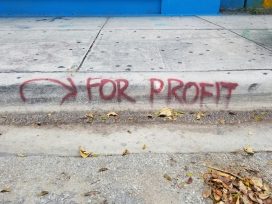
As capital consolidates, culture recedes, funding vanishes, access narrows. The question persists: why fund culture at all? Cultural managers from Austria, Hungary and Serbia discuss.
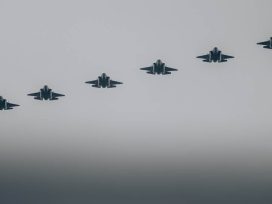
Russian drones entering Polish airspace, militarily seen as intensified provocation rather than open warfare, have nevertheless provoked costly responses – both from NATO’s air defence systems and civilian reactions to disinformation. A war correspondent’s view of what can be done technologically – for greater military efficiency and improved civil defence.



